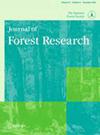什么样的现场景观体验能吸引潜在的访客?日韩跨文化比较
IF 1.1
4区 农林科学
Q3 FORESTRY
引用次数: 0
摘要
在大数据时代,社交媒体对现场景观体验的影响越来越大,场内与场外景观规划与管理的关系变得越来越重要。该研究的目的是:1)根据游客现场体验确定景点热点;2)根据游客在景点拍摄的照片明确景观偏好和吸引力;3)研究日本和韩国游客在景观偏好和吸引力方面的异同。这些数据是通过对153名日本高尾准国家公园游客的地理标记照片收集的,用于了解场外欣赏,并比较日本和韩国游客的体验。42名日本人和40名韩国人完成了基于照片的问卷调查。我们收集了1,645张地理标记照片,并利用基于网络的核密度估计进行GIS分析,以确定景点热点。从基于照片的问卷中提取的数据用于分析现场和非现场体验之间的关系,以及日本和韩国参与者之间的异同。采用均值、Welch’s t检验、Wilcoxon和秩检验、Pearson’s相关分析和Kendall’s相关分析对数据进行分析。调查结果显示,日本游客喜欢拍摄的照片不一定能吸引游客,也与韩国游客认为有吸引力的景点和物体不一样。随着国际旅游业的发展,跨文化研究对森林景观管理和可持续旅游变得越来越重要。关键词:景观感知景观偏好国家公园地理标记游客雇佣摄影致谢我们要感谢153名参与者和82名参与我们研究的受访者。披露声明作者未报告潜在的利益冲突。地理位置信息日本补充资料本文的补充数据可在线访问https://doi.org/10.1080/13416979.2023.2257456.Additional informationfunding本工作得到了JSPS [14J05265]的支持。本文章由计算机程序翻译,如有差异,请以英文原文为准。
What on-site landscape experiences attract potential visitors to a site? A Japan–Korea cross-cultural comparison
ABSTRACTIn the age of big data, social media’s influence on on-site landscape experiences is growing, and the relationship between on- and off-site landscape planning and management is becoming more important. The study’s objectives were: 1) to identify scenic hotspots based on on-site visitor experiences, 2) clarify landscape preferences and attractiveness based on photographs taken at scenic hotspots, and 3) examine similarities and differences between Japanese and Korean visitors in terms of landscape preferences and attractiveness. The data were collected using geotagged visitor employed photography from 153 visitors to the Takao Quasi-National Park in Japan were used to understand off-site appreciation, and compare Japanese and Korean visitors’ experiences. Photo-based questionnaires were completed by 42 Japanese and 40 Korean respondents. We collected 1,645 geotagged photographs, and performed a GIS analysis with network-based kernel density estimation to identify scenic hotspots. The data extracted from the photo-based questionnaire were used to analyze the relationship between on-site and off-site experiences, as well as similarities and differences between the Japanese and Korean participants. The data were analyzed using means, Welch’s t-test, Wilcoxon sum-rank test, Pearson’s correlation analysis, and Kendall’s correlation analysis. The results identified nine scenic hotspots, and revealed that the photographs that the Japanese visitors preferred to take would not necessarily attract tourists, nor were they the same as the scenic spots and objects the Korean visitors found attractive. As international tourism expands, cross-cultural research on on- and off-site experiences and preferences has become increasingly important for forest landscape management and sustainable tourism.KEYWORDS: Landscape perceptionlandscape preferencenational parkGISgeotagged visitor employed photography AcknowledgementsWe would like to thank the 153 participants and 82 respondents who joined in our research.Disclosure statementNo potential conflict of interest was reported by the author(s).Geolocation informationJapanSupplementary materialSupplemental data for this article can be accessed online at https://doi.org/10.1080/13416979.2023.2257456.Additional informationFundingThis work was supported by the JSPS [14J05265].
求助全文
通过发布文献求助,成功后即可免费获取论文全文。
去求助
来源期刊

Journal of Forest Research
农林科学-林学
CiteScore
3.00
自引率
6.70%
发文量
62
审稿时长
3 months
期刊介绍:
Journal of Forest Research publishes original articles, reviews, and short communications. It covers all aspects of forest research, both basic and applied, with the aim of encouraging international communication between scientists in different fields who share a common interest in forest science.
 求助内容:
求助内容: 应助结果提醒方式:
应助结果提醒方式:


